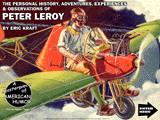
by Mark Dorset
Celeste Olalquiaga:
Dust is what connects the dreams of yesteryear with the
touch of nowadays. It is the aftermath of the collapse of illusions, a
powdery cloud that rises abruptly and then begins falling on things, gently
covering their bright, polished surfaces. Dust is like a soft carpet of
snow that gradually coats the city, quieting its noise until we feel like
we are inside a snow globe, the urban exterior transmuted into a magical
interior where all time is suspended and space contained. Dust makes the
outside inside by calling attention to the surface of things, a surface
formerly deemed untouchable or simply ignored as a conduit to what was
considered real: that essence which supposedly lies inside people and things,
waiting to be discovered. Dust turns things inside out by exposing their
bodies as more than mere shells or carriers, for only after dust settles
on an object do we begin to long for its lost splendor, realizing how much
of this forgotten object's beauty lay in the more external, concrete aspect
of its existence, rather than in its hidden, attributed meaning.
Dust brings a little of the world into the enclosed
quarters of objects. Belonging to the outside, the exterior, the street,
dust constantly creeps into the sacred arena of private spaces as a reminder
that there are no impermeable boundaries between life and death. It is
a transparent veil that seduces with the promise of what lies behind it,
which is never as good as the titillating offer. Dust makes palpable the
elusive passing of time, the infinite pulverized particles that constitute
its volatile matter catching their prey in a surprise embrace whose clingy
hands, like an invisible net, leave no other mark than a delicate sheen
of faint glitter. As it sticks to our fingertips, dust propels a vague
state of retrospection, carrying us on its supple wings. A messenger of
death, dust is the signature of lost time.
| Celeste Olalquiaga
The Artificial Kingdom: A Treasury of the Kitsch Experience, with Remarkable Objects of Art and Nature, Extraordinary Events, Eccentric Biography, and Original Theory, plus Many Wonderful Illustrations Selected by the Author |
Alan Wachtel:
Bear with me while I set this up by briefly reviewing fractal theory.
Most of the exposition comes from Complexification, by John L. Casti,
and The Beauty of Fractals, by H.-O. Peitgen and P. H. Richter.
Consider the sequence of complex numbers z(i
+ 1) = z(i)**2 + c, n = 0, 1, 2, . . ., c = constant. In general, z can
either converge to a fixed point, diverge to infinity, or execute some
more or less complicated bounded trajectory around an attractor. The set
of c for which the sequence beginning at z(0) = 0 does not diverge to infinity
is the Mandelbrot set M. M is connected, but its boundary in the complex
plane is fractal; values of c in various lobes of M correspond to particular
kinds of trajectories. The interior of M is conventionally shown in black,
and values of c outside M are colored to indicate how rapidly the corresponding
sequences escape to infinity.
Now, instead of fixing z(0) and letting c
vary, fix c and let z(0) vary. If c is in M, then, by definition, the sequence
beginning at z(0) = 0 does not diverge. Sequences that begin in a certain
region around 0 likewise do not diverge. This region is called the Julia
set of c, and its complement is called the Fatou set. The Julia set, in
general, is multi-lobed, and its boundary is fractal and self-similar.
If c lies outside M, however, the sequence
beginning at 0 diverges, and sequences beginning at most other complex
values also diverge. The Julia set, which contains the exceptions, then
dissolves into a Cantor set, or, with further variation of c, into a cloud
of uncountably many disconnected points called Fatou dust.
"Dust," then, seems to be a technical term
meaning a bounded set of uncountably many disconnected points. Further
examples are given by the two-dimensional analogues of the triadic Cantor
set, known in the triangular case as the Sierpinski gasket and in the square
one as the Sierpinski carpet. (I think it's especially fitting for a carpet
to be composed of dust. I've had a few like that.)
See:
At Home with the Glynns: For quite a while during the writing
of the book, I thought that I would call it War (Life, Love, Dust)
and Peas
E-mail it to me, Mark Dorset.

 Here
are a couple of swell ideas from Eric Kraft's vivacious publicist, Candi
Lee Manning:
Here
are a couple of swell ideas from Eric Kraft's vivacious publicist, Candi
Lee Manning:
